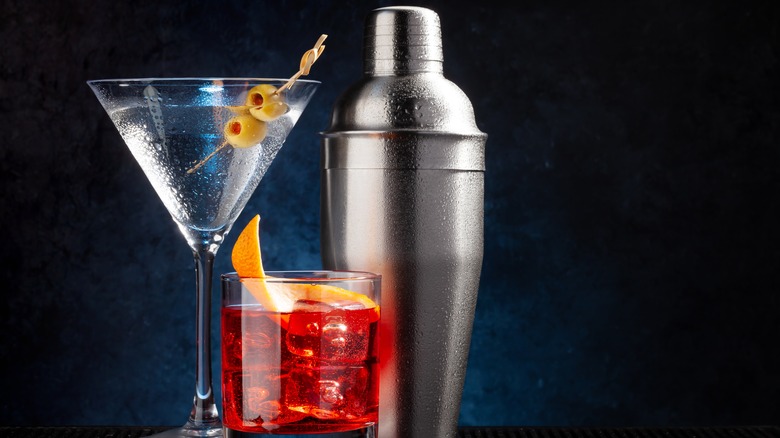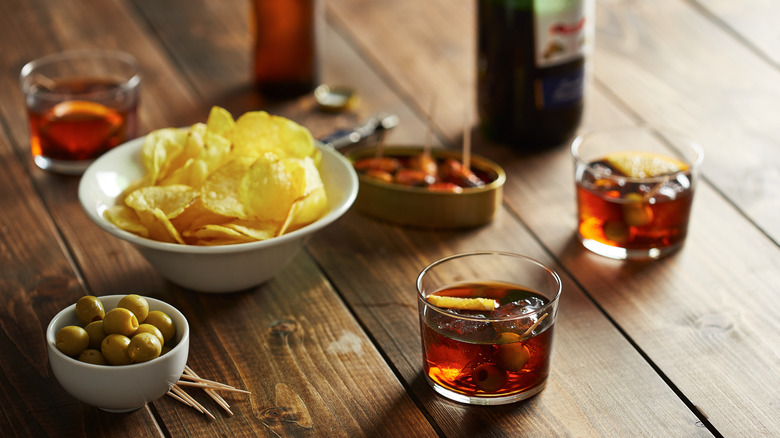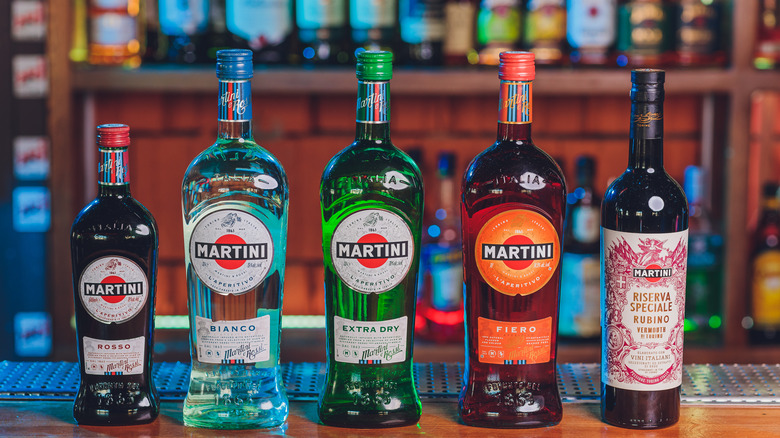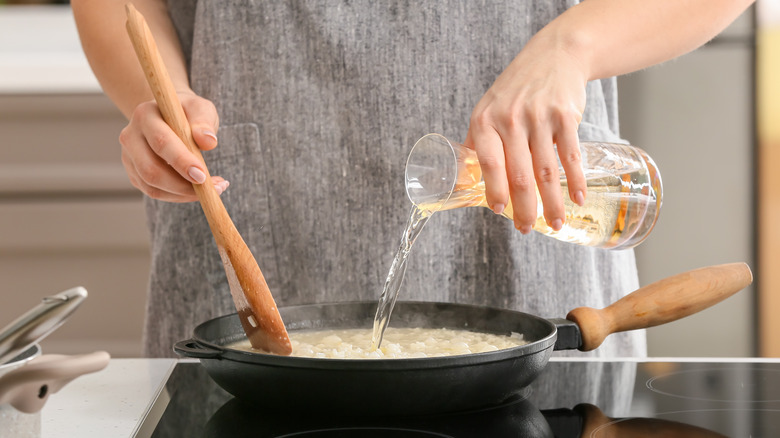Dry Vs. Red Vermouth: What's The Difference?
Vermouth has been undergoing a major revival following a boom in craft cocktail culture, notes Martha Stewart. Reworked into bar classics — think frozen negroni and vodka martini — the beverage is piquing the interest of many. Consequently, there's no better time than the present to learn about the differences in vermouth varieties.
Wine Enthusiast explains that vermouth can generally be classified as an aromatic, fortified wine with an ABV content between 14.5 and 22%. Infused with botanicals like artemisia, cardamom, nutmeg, cloves, rhubarb, chamomile, juniper, rose petals, vanilla, or citrus peels, every vermouth recipe is unique. While it can come in many forms, Decanter states that vermouth is often divided into two main categories: dry, which is always white, and sweet, which can be white but is typically red. Beyond a color difference, the two variations also range in origin, flavor, and use. Let's dig into the other differences between the two.
Similar origins
Steeping botanicals like herbs, barks, and roots in wine had long been a practice thought to have medicinal benefits. However, Liquor.com shares that the herb-infused wine didn't shift from medical elixir to beverage of pleasure until the mid-1600s when Germans began creating wermut, an aromatized wine made with wormwood. However, the first commercial vermouths can be traced back to Italy and France.
Although the Italian distiller Antonio Benedetto Carpano may have invented the first amber-colored, sweet vermouth in 1786 in the city of Turin, SFGate reports that the French herbalist Joseph Noilly wasn't far behind, crafting a pale, dry vermouth just decades later in 1813 in the coastal village of Marseillan.
Interestingly, Spain was also prompt to adopt a love of vermouth. In the mid-1800s, Punch explains that the Spanish welcomed both dry and sweet varieties, however, ultra-sugary reds are more commonly enjoyed during "la hora del vermut," an apértif hour dedicated to sipping vermouth.
Totally unique profiles
Although a range of botanicals can be used, according to VinePair, what differentiates dry and sweet (or red) vermouth styles is that dry vermouth tends to be less spicy and saccharine than red. Dry vermouth is sharper and cooler, as its flavor profile comes mostly from the herbs it's infused with, whereas sweet vermouth is infused with spices and botanicals, so it has a warmer feel. Though both vermouths begin with a white wine base, red vermouth gets its amber hue from the addition of caramelized sugar, according to Saveur.
That said, when it comes to the degree of sweetness, Myrecipes notes that dry vermouth usually is about 4% sugar, while red vermouth can reach 15%. This is why dry vermouth has a lighter and more crisp mouthfeel in comparison to red. Interestingly, barrel aging (typical of dry, French styles) can also affect the perception of sweetness, making dry vermouth taste a touch sweeter without increasing the amount of sugar, describes Wine Enthusiast.
Although both dry and red varieties can be enjoyed plain, their unique flavor profiles make them a great building block in cocktails. With an abundance of complexity in every bottle of vermouth, Imbibe explains that dry vermouth is essential in a martini, while red vermouth is pivotal in a negroni or a Manhattan.
Can the two styles be swapped?
Can dry and red vermouth be used interchangeably? In a word, sometimes. Given their unique flavor profiles, Tastylicious reports that swapping one for the other will dramatically change the taste of a cocktail — however, that might not be such a bad idea if you want to add a bit of bitterness or amp up the sweetness in a drink. If you're out of vermouth and are forced to substitute in another fortified wine, it's best to replace like with like. According to VinePair, dry vermouth can be replaced with dry sherry, whereas red vermouth can be swapped for sweet Madeira, Port, or even sweet wine.
Finding a proper alternative can be a bit complicated if you're cooking with vermouth. While dry vermouth can be substituted for an equal amount of white wine, Cook's Illustrated notes that red vermouth can be substituted with red wine but might require some additional sweetener.
Shelf life and storage
Since vermouth (dry or red) is a cross between a spirit and a wine, it can boast a slightly longer lifespan, but only when kept under the proper conditions. VinePair shares that storing it in the fridge will ensure that the bottle lasts for about a month before time starts taking a toll on quality. Thrillist says you'll know when vermouth is no longer good for drinking when it starts smelling like vinegar, but don't throw it out.
Vermouth past its prime is still perfectly suitable to cook with (via Feast + West). The Auguste Escoffier School of Culinary Arts blog states that any style of vermouth can be used wherever you'd use wine, be it braising, deglazing, or making sauces. Just remember that fortified wine has more intensity, so you might want to reduce the amount, so you don't impart too much herbaceousness or sweetness to your dish.




